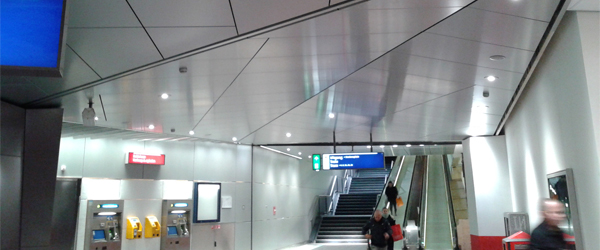Unique acoustic ceiling for Amsterdam’s Metro

Hunter Douglas produces unique acoustic ceiling for Amsterdam’s Metro
Hunter Douglas has produced an aluminium ceiling panel system for Amsterdam’s North-South subway line that retains their flat appearance and rigidity even at a maximum length of 2.5 metres. Most panels this size have a tendency to bend under their own weight. The rigidity of the new panels, manufactured at Hunter Douglas’ Rotterdam plant, is a result of the production process with a double layer of aluminium separated by a honeycomb filling. Their sound absorption (αw: 0.75) means the panels reduce the noise of metros and trains. At the request of Amsterdam’s Benthem Crouwel Architects, the panels have a high reflective value, too (82 per cent) – another characteristic resulting from the use of aluminium. This means the stations along the North-South Line will enjoy a large amount of reflected light. Erwin Verlegh, head of calculation and purchasing at Verwol Projectafbouw from Delft, explained: “We opted for Hunter Douglas, because of their ability to deliver standard panels that can be made to size on location. Using a single standard measurement also means we will not need any uniquely sized, more expensive panels. And if panels get damaged, it will be much easier to order additional ones this way. Hunter Douglas’ experience in using these products for subway and railway stations abroad is another added extra.”
Hunter Douglas’ research and development department spent almost a year working on the XL ceiling panels. The commissioning of the North-South Line accelerated production, enabling Hunter Douglas to align production with the specific needs of this project from an early design stage. Saartje van der Made, architect at Benthem Crouwel, said: “Each of the seven stations located along the North-South Line uniquely adapts itself to its position in the city. However, by designing the stations according to certain agreed dimensions and specifications, we´ve ensured that the subway line will be a recognisable entity within the city. The modest finishing will make it easy for travellers to find their bearings. The ceilings are to consist of uniform, rectangular panels mounted in the direction in which people will be walking and thus contributing to a sense of clarity and unity.”
The average size of the panels is 1.8 by 0.90 metres, although the Ceintuurbaan Station will feature panels as large as 2.5 by 1.25 metres. Developing big, flat panels like this is quite a challenge, said Bart van de Bult, Product Engineer at Hunter Douglas. “Single-layer panels tend to sag quite easily,” he added. “We´ve avoided that risk by making a sandwich panel, consisting of a double layer of aluminium separated by a honeycomb filling. It makes the panels far more solid. In the tests we performed, our panels didn´t bend a single millimetre.”
Underground stations in particular have a shortage of natural daylight. To make the stations as light as possible, the architect requested a reflecting ceiling. “Aluminium is a good reflector of light and warmth,” said Verlegh. “Benthem Crouwel also stressed the importance of noise reduction; they wanted to be sure the noise of subway trains wouldn´t be a nuisance. To improve the acoustics, we perforated the ceiling panels. The disadvantage of perforation is that it reduces the reflective value. We had to find the right balance. In the end, we achieved an NRC value of 0.75 and a reflection value of 82 percent. The reflection value will save a lot of energy on station lighting.”
Another advantage of the panels´ sandwich structure is that they can be sawn to size on location. Van de Bult explained: “The standard panels we produce are strong enough to be sawn to size, thanks to their double layer. The sawing can be done at the building site, where the measuring and fitting is done. You can’t do this with single-layer aluminium ceiling panels: they would break.”
The new Hunter Douglas panels are equipped with a so-called swing-down system: one side is mounted on the ceiling with a hinge, after which the other side is hoisted up to the ceiling and locked in place. Erwin Verlegh, of Verwol Projectafbouw, said: “Installing these panels takes far less time and effort. Also, they can be unlocked with a single click, which is convenient whenever the space above the ceiling needs inspecting.”
In the Central Station’s distribution hall, the structure for the ceiling has already been installed. The first of the unique Hunter Douglas panels were also recently mounted. The last of the stations connected by the North-South Line is to be completed in 2017.
